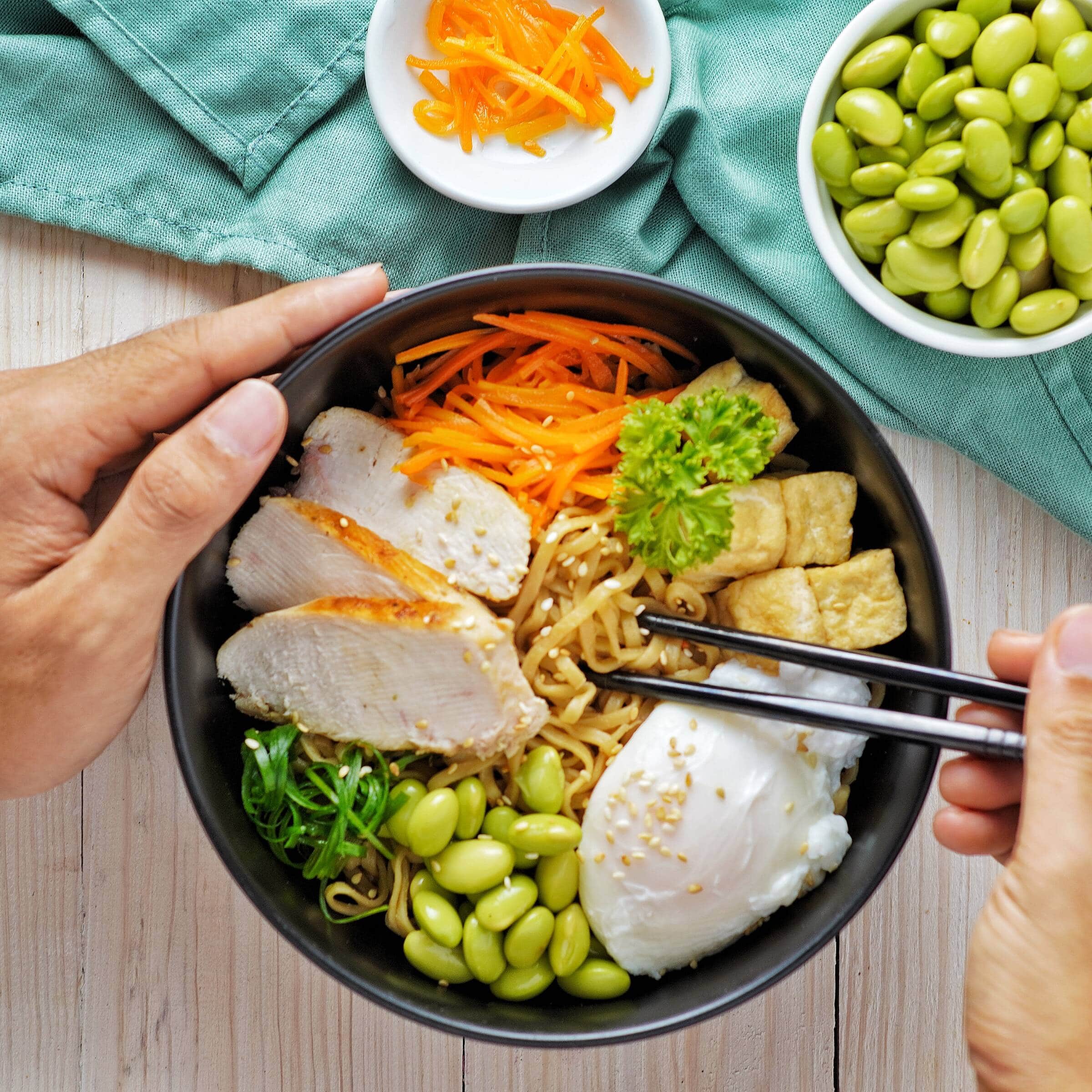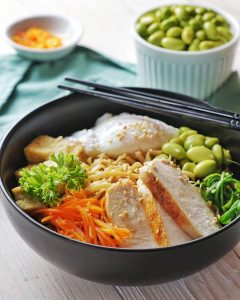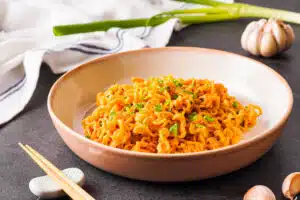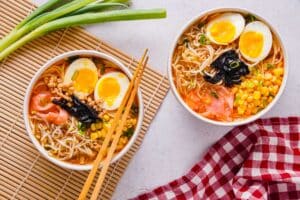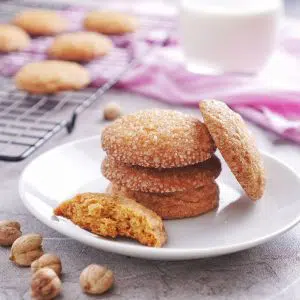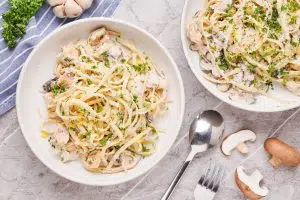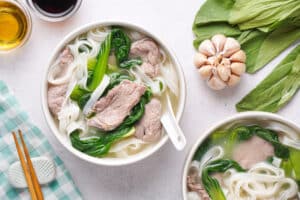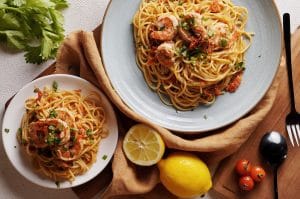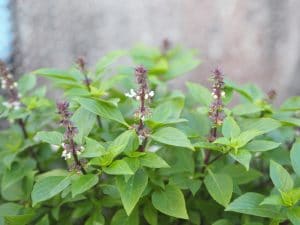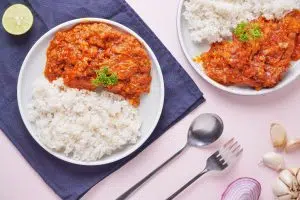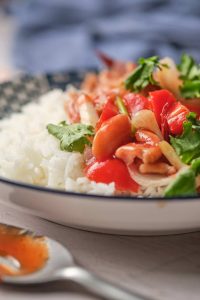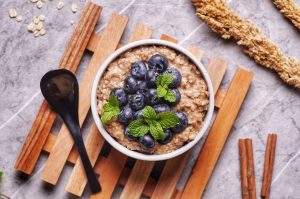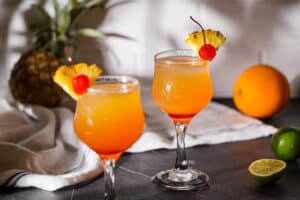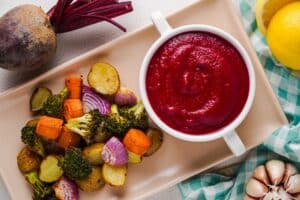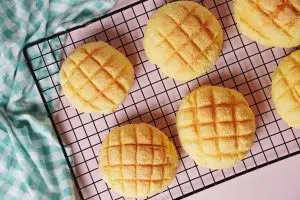What Are The Best Noodles For Ramen?
Important Note: When you buy through our links, we may earn a commission. As an Amazon Associate we earn from qualifying purchases. Content, pricing, offers and availability are subject to change at any time - more info.
Ramen bars and restaurants are springing up all over the world these days. If you ever had a ramen dish before, you may still clearly remember how it spoke to your soul! As a result, you may wonder how to make these delectable noodle soups at home. With that said, what are some of the best noodles to use for a ramen dish?
Although the most frequent ramen noodles are soba, somen, and udon, it boils down to personal choice. Alkaline water, commonly known as “kansui,” is required for ramen noodles to be termed “ramen.” The noodle texture varies depending on the water ratio, from thin and crispy to thick and chewy.
If you are not entirely familiar with ramen, it is always great to know what exactly they are, the different types of ramen, and where it originates from. Knowing all that will help you decide what the best noodles are from some of the best noodle choices that I’ll provide. So, What are the best noodles to make ramen with?
- The Best Noodles To Make Ramen
- The Different Types Of Ramen Noodle
- What Are Some Of The Different Types Of Ramen Dishes?
The Best Noodles To Make Ramen
Before getting straight into the noodles, if you’ve been to a local ramen bar, you’ll know that it is almost as if that shop had mastered the dish so well that it would seem impossible to replicate such a signature dish. The great news is that it’s not difficult at all!
However, the golden rule in this matter is to understand the origin of ramen, what defines the dish as ramen, and what ramen noodles are. Understanding this magnificent dish will undoubtedly help you decide what the best noodles are for you. So, what is ramen?
Ramen: What Is It?
While ramen has become synonymous with Japanese cuisine, it’s worth noting that Chinese wheat noodles inspired the dish. It’s one of those rare examples of cuisine that everyone can enjoy since it’s cheap and satisfying.
Ramen is a Japanese noodle soup meal made with Chinese–style wheat or egg noodles, cooked sliced pork, fresh scallions, and a slightly firmer–than–soft–boiled egg served in a thick broth.
On the other hand, Vietnamese pho features a lighter broth, rice noodles, and beef instead of pork. Depending on the area of Japan you’re in, there are countless variations, and new interpretations appear regularly.
In the United States, ramen shops usually categorize their bowls by flavoring or the sauce added to the master broth.
Shoyu, or soy sauce, is used in more robust, often spicy ramen; shio, or salt, is a lighter type that emphasizes the broth; and miso, or fermented soybean paste, is frequently used in vegetarian–style ramen for more umami.
On the menu, you’ll also find tonkatsu ramen, a pork bone–based soup steeped in aromatics and slightly thickened. Tonkatsu is the best way to get started with ramen if you’ve never tried it before.
What Are Ramen Noodles?
Wheat flour, salt, and alkaline water are combined to make ramen noodles. Surprisingly, the wheat flour used in ramen has a significant protein content. Depending on the manufacturer, it generally ranges from 10 to 13 percent.
If one element distinguishes ramen noodles from other noodle dishes, it has to be the usage of kansui. Known as alkaline water or lye water, Kansui contains potassium carbonate and sodium carbonate.
When creating the dough for the ramen noodles, it is the main component. The noodles cannot be termed ramen without kansui. The kansui is responsible for giving the noodles a glossy appearance as well as a soft yellow hue.
The Best Noodles To Make Ramen
Now that we’ve gone through the origin of the ramen noodles, the next issue is, “How can I choose the best noodles for me?” Choosing the most fantastic ramen noodles, like many other culinary undertakings, boils down to personal choice.
That is why you must investigate all of your alternatives. You may, for example, go with the fresh noodle option, which means getting your noodles directly from a farmer’s market.
If this isn’t a possibility, you should know that many fantastic ramen noodle brands are available for purchase online. These noodles are, without a doubt, the next best thing. Here are five of the best:
Hakubaku Organic Somen Japanese Noodles
This noodle pack offers the best value for money because it includes three noodles in one container. It contains Hakubaku Organic Soba, Hakubaku Organic Somen, and Hakubaku Organic Udon.
I like this noodle bundle for the sheer variety of options it provides. As previously indicated, you will be served soba, somen, and udon noodles. You are effectively given the perfect opportunity to explore your alternatives and determine your preferences by offering you those varieties.
As you might have recalled, several types of ramen noodles are cooked in various ways. It implies that by purchasing this noodle box, you are also challenging yourself to try a variety of ramen preparations.
If you’re new to ramen, though, this noodle box would be an excellent place to start.
These Noodles Feature:
- Easy to make – this recipe comes with simple, easy-to-follow cooking directions that are ideal for you and your family.
- Buying this batch is perfect if you’re making ramen for a bunch of people who can’t get enough.
- The variety – this three-pack contains every taste and texture that a ramen noodle has to offer.
- These noodles are dry and will last for months if kept at room temperature in the pantry.
Sukina Buckwheat Soba Noodles
If you want to have an authentic and tasty ramen experience in the comfort of your own home, these Sukina noodles are perfect. They have a thick texture and are luxurious and smooth, making them excellent for any ramen recipe.
They not only provide a distinct taste to your broth, but they’re also straightforward to use. You’ll have a hard time finding buckwheat noodles that compare to these. When you get the opportunity, I strongly advise you to taste these noodles.
These Noodles Feature:
- Buckwheat absorbs water and broth much more efficiently than other whole grains, so your ramen will last longer.
- Easy to make – drop them in some water, and you’ll have excellent ramen in under an hour.
- You can make a colossal ramen supper for yourself and a few other people with this extensive package.
- The value of this product is unbeatable, so pick up a couple of packets right now!
Lotus Foods Millet & Brown Rice Ramen Noodles
Then there’s something a little different. These noodles are ideal for ramen fans who want to expand their knowledge of what creates outstanding ramen.
As you may have observed, this ramen noodle pack does not use wheat to produce its noodles. Instead, valuable, organic, whole grain rice is used. As a result, the noodle has a decreased salt content and is gluten and MSG–free.
There is, of course, no point to this if the noodles aren’t tasty. Fortunately, this is not the case. The inclusion of millet and brown rice gives it a delightfully nutty flavor without sacrificing the qualities that make ramen noodles outstanding.
Brown rice is also high in protein and fiber, making it an exceptionally healthy food. Granted, this may appear to be an odd option, particularly to ramen aficionados. However, keep in mind that ramen is a cuisine that is constantly evolving. Lotus’ ramen noodles are a great illustration of ramen’s flexibility and diversity.
These Noodles Feature:
- This ramen is rather distinctive; it’s made of rice and has a distinct flavor that will go well with specific toppings like egg or spinach.
- It has all of the classic features of ramen, so it’s still a good option for someone new to this delicious Japanese cuisine.
- It is heavy in protein and fiber, so if you’re looking for a healthy way to reduce weight, this is the one to go for.
- This ramen comes with everything you need to make a variety of ramen meals in a short amount of time.
King Soba Organic Buckwheat Ramen Noodles
The King Soba Organic Buckwheat Ramen comes next. This noodle is ideal if you’re searching for something simple, tasty, and quick to cook. There are no frills with King Soba ramen noodles, and It’s straightforward to put together.
King Soba has offered us a very adaptable ramen component by relying on its simplicity. Simplicity lends itself to flexibility, as any home cook can tell you.
These noodles are one of our favorites since they don’t go out of their way to irritate your taste senses, as they blend well with many broth recipes. As a result, they provide the ideal chance to learn how to make ramen from scratch.
Feel free to play with the various items you have on hand, such as veggies, miso, tofu, and various meats. They’re all fantastic with these noodles. Three separate packets of noodles are included in this noodle box.
Each one makes a big bowl of hearty ramen in the convenience of your own home. These King Soba ramen noodles are well worth the money, and I strongly advise you to try them yourself.
These Noodles Feature:
- Because it comprises buckwheat, it’s one of the more long-lasting ramen dinners on the list. It works well with egg, tofu, and seaweed toppings.
- It’s simple to make: these ramens are meant for individuals on the go, so simply heat them and eat them in minutes.
- There are enough noodles in three packages to mix a fast lunch or dinner in a couple of minutes.
A-SHA Tainan Vegetarian Ramen Noodles
These slimmer noodles have the most ramen–like texture. They swell up quite a bit, are considerably healthier, and are just as authentic as the noodles from your neighborhood shop (nothing beats fresh, though, just saying).
As you swallow, you don’t receive that sharp, acidic sensation. The texture is ideal, the noodles are pretty long, and each box includes various delicious flavor packs. They come in hot and moderate varieties, with each serving size having its sauce packet.
There are about 5-6 individual size servings in each big bag, and more sauce from your home kitchen can be added if needed (I sometimes add some Soy Vay spicy sauce to A-SHA’s because I like them extra spicy).
I usually like to add shredded carrots, green onion, sautéed white onion/red onion, and cilantro, which enhances the flavor of the already amazing-tasting noodles.
These Noodles Feature:
- Unlike other instant noodles, our ramen noodles are air-dried to maintain freshness and taste and are created with natural ingredients.
- Their quick noodles are made with whole wheat and are high in fiber, low in carbohydrates, and low in calories. They’re a healthy substitute for quick noodle soup.
- Choose from a variety of somewhat chewy noodle styles, including thin Tainan, medium Mandarin, broad, flat Hakka, and extra-wide knife cut.
- Choose from original, sesame paste, onion, extra-spicy ghost pepper, chili (mala), spicy BBQ, spicy fennel, or sesame oil scallion flavored Asian noodles.
The Different Types Of Ramen Noodle
I want to look at how each ramen meal may be prepared now that I’ve given you a quick explanation of the ramen noodle’s distinctive makeup. Everything you add into the broth, from the soupy foundation to the extra components you use, may impact the overall result.
Various ramen noodles are available, each with a different texture and consistency, ranging from thin and stringy to thick and chewy. When it comes to preparing your ramen meal, it all comes down to personal choice.
Another consideration while making ramen is the manner of preparation. The sort of ramen you receive at the end is ultimately determined by how much water is added during the kneading process. The ultimate consistency and texture of your noodle will be affected by this.
There are three significant sorts of noodle categories, each with its texture and nutritional value:
- Low water ratio noodles have a considerably greater water content, ranging from 25% to 31% liquid to wheat weight. They are significantly thicker and chewier than other varieties of ramen noodles while having the thinnest form.
- Noodles with a medium water ratio have significantly more water than the preceding noodles, ranging from 32% to 39% liquid. They have a softer consistency and a thicker form than those with a low water ratio.
- Noodles with a high-water ratio are incredibly soft and stringy, melting in your mouth as soon as you bite into them. They contain around 40% water and have consistency, and feel comparable to udon noodles.
The ultimate shape, texture, and even flavor of the ramen are all influenced by the water ratio. It will also impact the ramen’s capacity to absorb the kansui water used in its preparation.
A higher water-to-flour ratio will result in softer ramen noodles, while a lower water-to-flour ratio will result in ramen noodles with a distinct crunch. Next time you buy noodles, look at the water consistency on the package and decide what texture you want.
What Are Some Of The Different Types Of Ramen Dishes?
The tare, or foundation flavor, determines the kind of Japanese ramen: shio, which is salt-based ramen; shoyu, which is soy sauce-based ramen; miso, which has soybean paste-flavored ramen; and tonkotsu which is pork bone broth ramen.
While these ramen flavors may be found anywhere in Japan, many regions have developed distinct regional variants. It is because kansui has a distinct influence on noodles. Below you’ll discover some of Japan’s most well-known and enjoyable regional ramen types, and you may even search up their recipes to try at home.
Kansui has an impact on the texture, look, and flavor of ramen noodles. The alkaline salts used in kansui, for example, give the dish a distinct taste, and the alkalinity reacts differently with the wheat in the noodles.
Furthermore, the alkalinity in kansui contributes to the noodles’ uniquely slippery texture, which is unique to ramen noodles. At the same time, the alkalinity has an impact on the look of the noodles.
10 Delectable Different Ramen Types
Sapporo Miso Ramen
The dish was created in Sapporo, the capital of the northernmost province of Japan, Hokkaido. Miso ramen is so popular among residents that there are two ramen “alleys” in the city: Ganso Ramen Yokocho and Shin Ramen Yokocho.
Preparation of this regional specialty, aromatic soybean paste is sautéed with ginger and garlic before being combined with pig broth to form a hearty bowl of ramen that will warm you up on even the harshest winter days. It is topped with roasted chashu pork, bamboo shoots, and bean sprouts.
You may also ask for corn and a creamy pat of butter, both of which are Hokkaido specialties.
Hakata Tonkotsu Ramen
Tonkotsu ramen from Hakata (modern-day Fukuoka) is a distinctive kind of ramen prepared from pig bones that have been made at a high temperature until the collagen has been released, resulting in a rich and milky broth that is cut with seafood stock.
Thin straight noodles, cooked just under al dente, are topped with thick slices of roasted pork, garlic, sesame seeds, and pickled ginger in this ramen. It’s customary to get a second serving of noodles, known as kaedama if you finish the noodles fast.
Tonkotsu ramen is a kind of ramen that originated in Kyushu and has since spread throughout Japan and to many other nations.
Kitakata Ramen
The Kitakata region of northern Fukuoka is known for its hand-cut noodles and ramen prepared with thick, wavy egg noodles. It’s served in a shoyu (soy sauce) broth with a few slices of chashu pork, bamboo shoots, and a piece of naruto, a pink and white spiraled fish cake.
Despite the ingredients being simple, a bowl of Kitakata ramen is the iconic picture of ramen for many Japanese people.
Wakayama Ramen
Locals in Wakayama prefecture frequently request Chuka soba, or “Chinese-style noodles,” rather than ramen. You’ll get a bowl of tonkotsu-shoyu ramen, which combines pig bone broth from western Japan with soy sauce-based ramen broth from eastern Japan.
The noodles are thin and stick straight, akin to Hakata ramen, and are topped with scallions and a slice of shoyu ramen’s pink-and-white naruto fish cake. It’s also usual to have haya-zushi, a classic Kansai-style pressed sushi prepared with pickled mackerel, alongside your ramen.
Onomichi Ramen
Onomichi is a beach town on the Seto Inland Sea in Hiroshima Prefecture, so it’s no wonder that their distinctive type of ramen is cooked using fresh local fish. The shoyu-based soup also has chicken and pig, but the show’s star is a layer of rich hog back fat suspended on top, which gives it a taste boost.
Ramen lovers queue daily at Onomichi’s numerous ramen restaurants to taste Onomichi ramen.
Nagoya (Taiwan) Ramen
Despite its name, Nagoya’s unique type of ramen isn’t a direct import from Taiwan; however, it is inspired by Taiwanese cuisine. It’s called after a Taiwanese chef who came up with the meal made using Taiwanese danzai noodles.
Ramen noodles in a shoyu broth with spicy ground pork and nira are the main ingredients of Taiwan ramen (garlic chives). The dish predates Japan’s spicy cuisine craze, yet its appeal has endured over the decades!
Okinawa Soba
The Ryuku Kingdom, a series of islands off Japan’s southwestern point, was formerly an autonomous archipelago apart from the rest of the country. Ryuku had its unique language, culture, and cuisine, as well as its kind of ramen known as “Okinawa soba.”
While referred to as “soba,” the noodles are more akin to udon flour noodles and are served in a ramen-style broth with pork, bonito fish flakes, and seaweed. Compared to other types of ramen, Okinawa soba includes unusual toppings such as bone-in pork ribs and pig trotters.
Nagasaki Champon
Although not a kind of ramen, champon is a Nagasaki regional cuisine made with thick egg noodles remarkably similar to ramen. Along with meat, veggies, and shellfish, the noodles are cooked directly in the soup.
Champon was created as a low-cost meal for Chinese students studying in Nagasaki, and it combines Chinese and Japanese cuisines.
Kurume Ramen
Kurume ramen is a traditional Kyushu ramen type that predates even the well-known Hakata tonkotsu ramen. Kurume City ramen also utilizes a tonkotsu pig bone broth, but it’s thicker and heavier than Hakata ramen and has a more potent pork fragrance.
Kagoshima Ramen
The only place in Kyushu that Kurume City’s thick tonkotsu ramen hasn’t impacted is Kagoshima. Instead, a mixed broth of pork, chicken, dried sardines, vegetables, and dried shiitake mushrooms are used in this ramen, topped with charred scallions.
The foggy soup has a mellow taste that distinguishes itself from other ramen made from the Kyushu region.
Making your very own heavenly ramen at home is possible with all these fantastic noodle alternatives. With kansui included, each noodle can blend in with any style of ramen that represents all sorts of textures, flavoring, and presentation.
When you’d like to try it for yourself, there are many different signature dishes to try from various locations in Japan that can certainly please many pallets.
